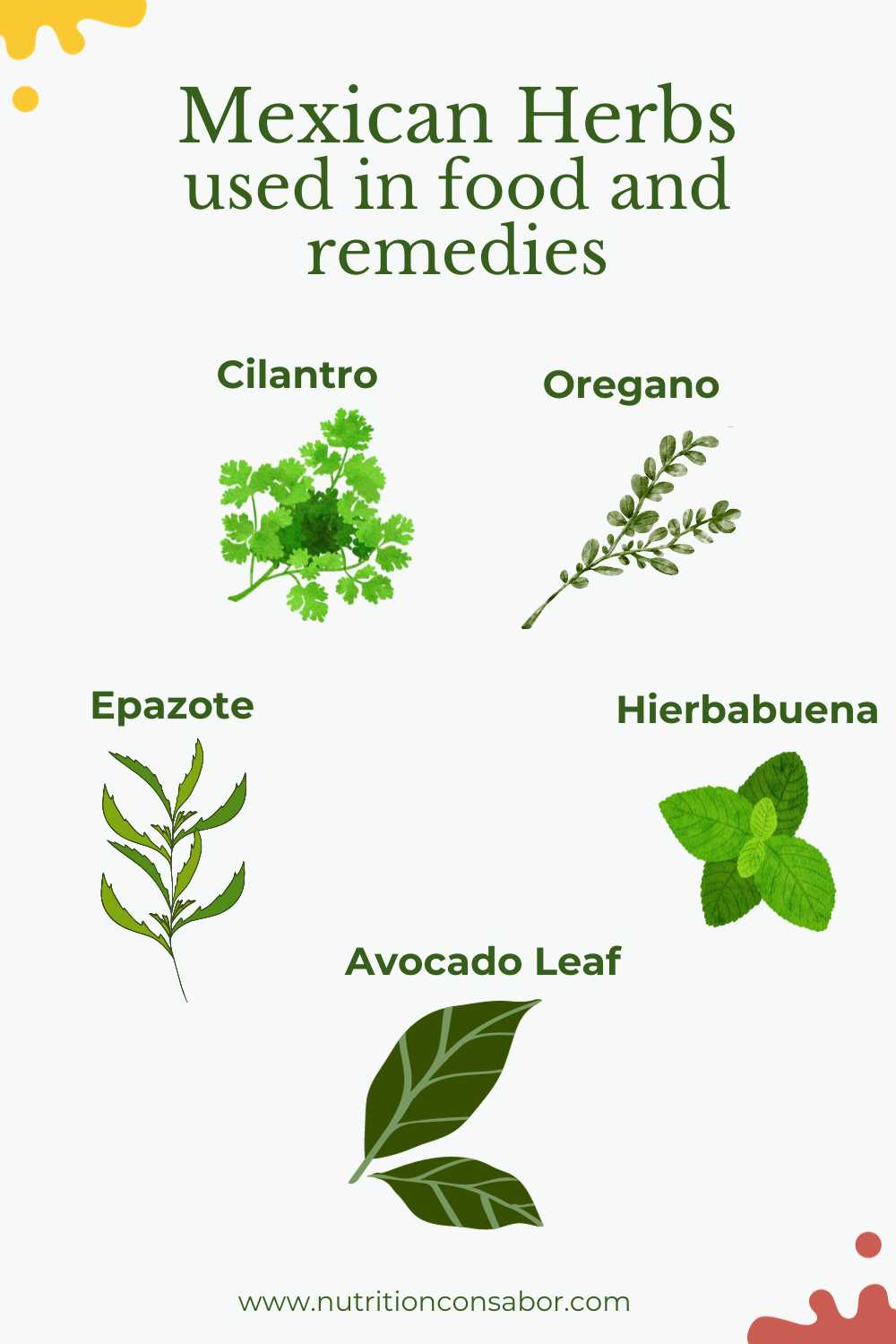Mexican herbs and spices add their signature flavor to Mexican food. But did you know they can also provide some incredible health benefits?
Yes, cooking with herbs can help promote healthy gut bacteria, or even protect against oxidative stress (1,2).
Keep reading for a full breakdown of all the traditional Mexican spices and herbs and their health benefits.
Important disclaimer: all nutrition benefits outlined in this article assume culinary use. This article is purely informational and does not constitute medical advice. I do not recommend taking herbal supplements, unless otherwise advised by your doctor.
Herbs are generally safe in food, but supplements may pose a greater risk. Please consult your healthcare provider.

Mexican Herbs
Mexican dishes frequently contain fresh herbs, as well as dried herbs. These not only add flavor, but can provide significant health benefits as well. Here are some common herbs in authentic Mexican food, as well as their health benefits.
Cilantro
Cilantro is one of the most popular Mexican herbs. You’ll find it sprinkled on top of tacos, tostadas, and soups. It’s also an important ingredient in salsas.
Nutrition
Cilantro leaves are high in vitamin K, which is important for bone health and blood clotting (3, 4).
Cilantro leaves may also help lower blood sugar and triglycerides, although more research is needed on that front (5).
Epazote
Epazote is a strong-tasting herb frequently used in Mexican stews and beans. According to Mexican tradition, cooking beans with epazote will reduce stomach discomfort from eating beans. Epazote can be used fresh or dried.
Nutrition
Epazote is a rich source of quercetin (6). Quercetin is an antioxidant which may protect against free radical damage (7).
It should be noted that cooking with an herb is different from using it as medicine. Epazote can cause harm and even death when taken in large quantities or as an essential oil (8).
Cooking with epazote is generally considered safe, since its strong flavor means you’ll use small servings. For more information on safety of epazote, check out this guide.
Oregano
Oregano in Mexican food is actually different from Italian or Greek oregano.
Quick cooking tip: buy Mexican oregano to give your Mexican cooking a more authentic taste. If you can’t find Mexican oregano, marjoram is a closer substitute than Italian or Greek oregano.
Mexican oregano adds depth to meat and poultry dishes, as well as most stews. Traditional Mexican medicine also uses oregano frequently.
Nutrition
In addition to its signature flavor, Mexican oregano has antimicrobial properties (9). Plus like many other herbs and spices, oregano is a good source of antioxidants and polyphenols (10).
Finally, early evidence suggests oregano may decrease fat and carbohydrate absorption (11). However, more research in humans is needed to fully evaluate this effect.
Hierba Buena
Hierba buena actually refers to a variety of wild mints. However, one of the most common varieties of hierba buena is spearmint.
Hierba buena is a common feature of Mexican traditional medicine. Practitioners of Mexcian traditional medicine use hierba buena as a cure for indigestion, among other uses (12).
In food, you will find hierba buena in desserts or drinks more than a savory main dish.
Nutrition
In addition to its use in traditional medicine, hierba buena has antibacterial properties. Its also a good source of various antioxidants and flavonoids, which can help fight inflammation (13).
Thyme
Thyme is one of the most important herbs in Mexican cuisine, especially for slow-cooked meat dishes (think barbacoa).
Nutrition
Thyme is a good source of vitamin A, vitamin C, vitamin B6, and potassium. Thyme may also help prevent cancer and inflammation (14).
Avocado leaf
It’s no secret avocado is a key ingredient in Mexican food. But did you know avocado leaves are commonly used as an herb?
You can use avocado leaves anywhere you would use a bay leaf, like soups, stews, and braised beans. Avocado leaf has a subtle licorice flavor.
Nutrition
Avocado leaves provide different nutritional benefits than the avocado itself. Avocado leaf may help lower blood sugar (15). Avocado leaves are also a rich source of antioxidants and polyphenols (16).
Bay leaf
In addition to avocado leaf, bay leaf is also used to flavor soups, stews, and braised dishes in Mexican food.
Nutrition
Consuming bay leaf may help reduce blood sugar and cholesterol (17). One study found drinking bay leaf tea may increase good cholesterol (18).
Pápalo
Papalo is an herb that tastes similar to cilantro. It’s particularly popular in Puebla.
Nutrition
Papalo is an anti-inflammatory plant (19). It is a rich source of antioxidants (20). Researchers are investigating this plant for potential kidney-protective benefits (21).
Amor Seco
Amor seco is the common Spanish name for the plant Bidens pilosa. Bidens pilosa is mostly an herbal remedy, but there are also some culinary uses for it. You may see it as an herb in salads or soups.
Nutrition
Amor seco may help lower blood sugar, improve insulin resistance, and increase glucose tolerance (22). This may be why it’s a common folk remedy in Mexican culture.

My Top Picks for Mexican Herbs
This section includes my product recommendations and affiliate links. This means if you click the link and make a purchase I may receive a commission. This does not affect the information in this article or my recommendations.

I highly recommend purchasing Mexican oregano for use in Mexican cooking. The basic oregano you find at the supermarket has a slightly different flavor profile.

I love to use whole avocado leaves in soups or stews. It adds a slightly sweet flavor to soups.
Final Thoughts
Mexican food, as well as traditional Mexican medicine, makes great use of herbs. Not only does this add flavor, but plenty of health benefits as well!
This is why I work with my clients to get herbs and spices at every meal. Ready to learn more about Mexican food and nutrition? Start your journey with my free 5-day Latino meal planner tool. Sign up below to get your copy!
